

TOR. Metadata. Metadata is "data about data".[1] There are two "metadata types;" structural metadata, about the design and specification of data structures or "data about the containers of data"; and descriptive metadata about individual instances of application data or the data content.
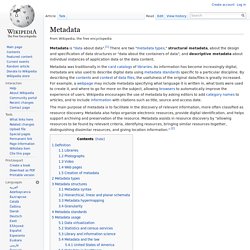
The main purpose of metadata is to facilitate in the discovery of relevant information, more often classified as resource discovery. Metadata also helps organize electronic resources, provide digital identification, and helps support archiving and preservation of the resource. Metadata assists in resource discovery by "allowing resources to be found by relevant criteria, identifying resources, bringing similar resources together, distinguishing dissimilar resources, and giving location information. " [2] Definition[edit] Web Photo Geotags Can Reveal More Than You Wish. PRISM (surveillance program) Below are a number of slides released by Edward Snowden showing the operation and processes behind the PRISM program.
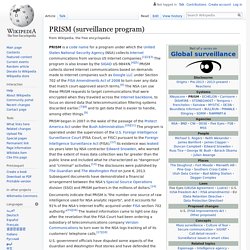
It should be noted that the "FAA" referred to is Section 702 of the FISA Amendments Act ("FAA"), and not the Federal Aviation Administration, which is more widely known by the same FAA initialism. ECHELON. ECHELON[needs IPA], originally a code-name, is now used in global media and in popular culture to describe a signals intelligence (SIGINT) collection and analysis network operated on behalf of the five signatory nations to the UKUSA Security Agreement[1] — Australia, Canada, New Zealand, the United Kingdom, and the United States.
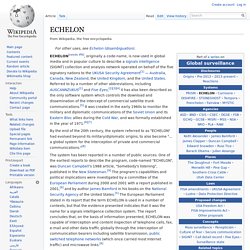
Referred to by a number of other abbreviations, including AUSCANNZUKUS[1] and Five Eyes,[2][3][4] it has also been described as the only software system which controls the download and dissemination of the intercept of commercial satellite trunk communications.[5] It was created in the early 1960s to monitor the military and diplomatic communications of the Soviet Union and its Eastern Bloc allies during the Cold War, and was formally established in the year of 1971.[6][7] §Name[edit] Room 641A. Coordinates: Room 641A is a telecommunication interception facility operated by AT&T for the U.S.
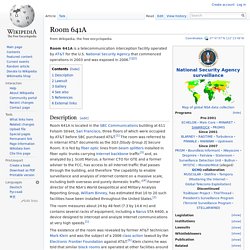
National Security Agency that commenced operations in 2003 and was exposed in 2006.[1][2] §Description[edit] The existence of the room was revealed by former AT&T technician Mark Klein and was the subject of a 2006 class action lawsuit by the Electronic Frontier Foundation against AT&T.[5] Klein claims he was told that similar black rooms are operated at other facilities around the country.
§Lawsuit[edit] The Electronic Frontier Foundation (EFF) filed a class-action lawsuit against AT&T on January 31, 2006, accusing the telecommunication company of violating the law and the privacy of its customers by collaborating with the National Security Agency (NSA) in a massive, illegal program to wiretap and data-mine Americans' communications. §Gallery[edit] Utah Data Center.
The Utah Data Center area layout.
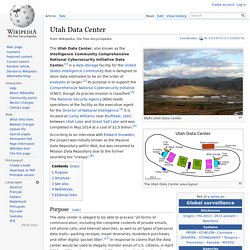
The Utah Data Center, also known as the Intelligence Community Comprehensive National Cybersecurity Initiative Data Center,[1] is a data storage facility for the United States Intelligence Community that is designed to store data estimated to be on the order of exabytes or larger.[2] Its purpose is to support the Comprehensive National Cybersecurity Initiative (CNCI), though its precise mission is classified.[3] The National Security Agency (NSA) leads operations at the facility as the executive agent for the Director of National Intelligence.[4] It is located at Camp Williams near Bluffdale, Utah, between Utah Lake and Great Salt Lake and was completed in May 2014 at a cost of $1.5 billion.[5] A Close Look at the NSA’s Most Powerful Internet Attack Tool.
N.S.A. Devises Radio Pathway Into Computers. GCHQ has tools to manipulate online information, leaked documents show. Gait analysis. Gait analysis laboratory equipped with infrared cameras and floor mounted force platforms.
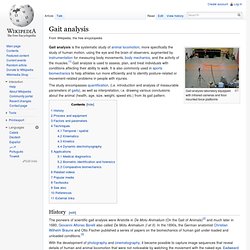
MIT researchers measure your pulse, detect heart abnormalities with smartphone camera. Last year, a group of researchers from MIT’s Computer Science and Artificial Intelligence Lab (CSAIL) showed us just how easy it is to “see” a human heartbeat in ordinary video footage.

Getting the Message? Police Track Phones with Silent SMS. In June 2011, Colette Giudicelli, a senator representing the Maritime Alps region of France, wrote to Claude Gueant, the French Interior Minister: Many foreign police and intelligence services use clandestine “Silent” SMS to locate suspects or missing persons.
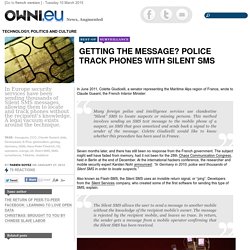
This method involves sending an SMS text message to the mobile phone of a suspect, an SMS that goes unnoticed and sends back a signal to the sender of the message. FBI lets suspects go to protect 'Stingray' secrets - Mar. 18, 2015. The device, called a "Stingray," tricks cell phones into revealing their locations.
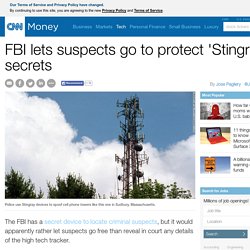
A judge's court order this week threatens to reveal closely guarded details about how police use Stingrays. Judge Patrick H. NeMoyer in Buffalo, New York, described a 2012 deal between the FBI and the Erie County Sheriff's Office in his court order Tuesday: The FBI instructed the police to drop criminal charges instead of revealing "any information concerning the cell site simulator or its use.
" How Your Phone Camera Can Be Used to Spy on You. In his recent television interview with NBC's Brian Williams, former NSA analyst Edward Snowden outlined the kind of spying techniques government agencies are capable of.

One segment was particularly troubling. In it, Snowden described how a hacker could potentially hijack the camera in Williams' pre-paid smartphone and use it to capture photos, video, and audio without his knowledge. But is something like that really possible? Can someone really activate your camera without your consent? Several recent revelations seem to suggest that the answer is yes. Back in December, German news magazine Der Speigel published alleged NSA documents that it claimed were sent by Snowden. U.S. Spies on Millions of Cars. A New Underclass: The People Who Big Data Leaves Behind. BitTorrent Opens Alpha For Maelstrom, Its New, Distributed, Torrent-Based Web Browser. Federal agents fly planes that spy on American cell phones - Nov. 13, 2014. NEW YORK (CNNMoney) On Thursday the Wall Street Journal cited unnamed sources who said the planes carry a box that serves as a dummy cell phone site. That device mimics actual towers, duping nearby cell phones into connecting to it instead of a real phone company tower.
Unmanned aerial vehicle. A group photo of aerial demonstrators at the 2005 Naval Unmanned Aerial Vehicle Air Demo. An unmanned aerial vehicle (UAV), commonly known as drone, is an aircraft without a human pilot aboard. Its flight is controlled either autonomously by onboard computers or by the remote control of a pilot on the ground or in another vehicle. The typical launch and recovery method of an unmanned aircraft is by the function of an automatic system or an external operator on the ground.[1] Historically, UAVs were simple remotely piloted aircraft, but autonomous control is increasingly being employed.[2][not in citation given]
Printer steganography. An illustration showing small yellow tracking dots on white paper, generated by a color laser printer. Seeing Yellow. CD Burners Leave “Fingerprints” Hacking Exposed Computer Forensics Blog. How the NSA can 'turn on' your cell phone remotely - Jun. 6, 2014. I don't think I'll ever understand the point of non-removable batteries. Paranoid or Prudent: Should You Tape Over Your Webcam? - Reviewed.com Cameras. Hacked from China: Is your kettle spying on you? Any iPhone can be hacked with a modified charger in under a minute. Proof That Military Chips From China Are Infected? For years, everyone has warned that counterfeit microchips made in China and installed on American military hardware could contain viruses or secret backdoors granting the Chinese military cyber access to U.S. weapons systems. How to bypass an Android smartphone’s encryption and security: Put it in the freezer. Security researchers at the University of Erlangen-Nuremberg in Germany have shown that they can extract photos, surfing history, and contact lists from Android smartphones, even if the phone is locked and the disk is encrypted.
New Research Result: Cold Boot Attacks on Disk Encryption. Microchips in our passports and credit cards: Are they safe? Hacker's Demo Shows How Easily Credit Cards Can Be Read Through Clothes And Wallets. The Rise of Thin, Mini and Insert Skimmers. Bluesnarfing. Foreign Intelligence Surveillance Act. Why the FISA Amendments Act Is Unconstitutional. An Evil USB Drive Could Take Over Your PC Undetectably. Air gap (networking) Acoustic Snooping on Typed Information. Scientist-developed malware covertly jumps air gaps using inaudible sound. Acoustic cryptanalysis. Extracting audio from visual information. Tempest (codename) When Should You Use Shielded vs. Unshielded Ethernet Cable? Satellite Hacking. How to Hack WIFI Password in 2 Minutes.
5 Wi-Fi security myths you must abandon now. Wired networks may leak, but they don't broadcast. Local shared object. HTTP cookie. Block websites from storing site preferences or login status in Firefox. Pop-up ad. Temporary folder. Browser Fingerprinting - Panopticlick. Certificate authority - Is there anything preventing the NSA from becoming a root CA? Federal Public Key Infrastructure.